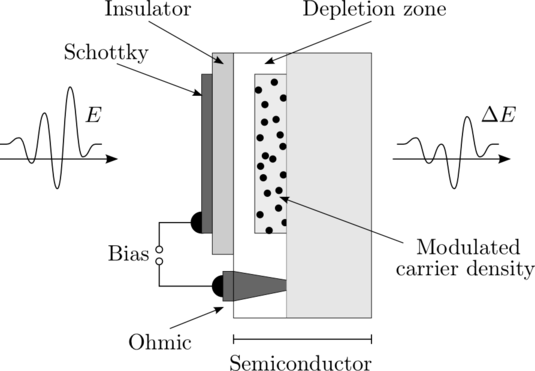B) Electromodulation spectroscopy
Over the past years we further developed THz electromodulation spectroscopy for semiconductor characterization. Time-resolved THz spectroscopy is a versatile tool for investigating the ultrafast dynamics of charge carriers within semiconductors. The conceptual idea of our approach is that the carrier density can be controlled with high accuracy by electronic means. This allows for a precise quantitative analysis of the THz radiation transmitted through the semiconductor. The technique yields the charge carrier's fundamental transport parameters, which are not accessible by conventional characterization methods in most modern semiconductors.
 |
Fig 3: Schematic of a device for THz electromodulation spectroscopy. Injecting charge carriers affects both, absorption and dispersion of the THz radiation. |
The transport properties of the charge carriers become measurable, when the electromagnetic field of the transmitted THz radiation is modulated by electronic injection or extraction of charge carriers [1]. Comparing the resulting modulation spectra with the injected charge carrier density provides the carrier's conductivity effective mass m*, and the Drude scattering time τ [2,3]. These two fundamental properties yield further important quantities, such as the carriers' mobility or conductivity, which are important for any electronic application.
Figure 4 shows studies on silicon, which were performed for finding the capabilities of THz electromodulation spectroscopy [2]. The main objective of current activities is to enhance the sensitivity of the technique. The goal is to reach sensitivities that allow for characterizing materials with low mobilities of about 1 cm2/Vs as they are present in many thin films of novel semiconductors and nanomaterials.
| Fig 4: Switching a silicon device from equilibrium a) to accumulation b), depletion c), and inversion d). The THz transients show the pulse transmitted trough the structure as well as the corresponding modulation signals. |

